May 28, 2024 —
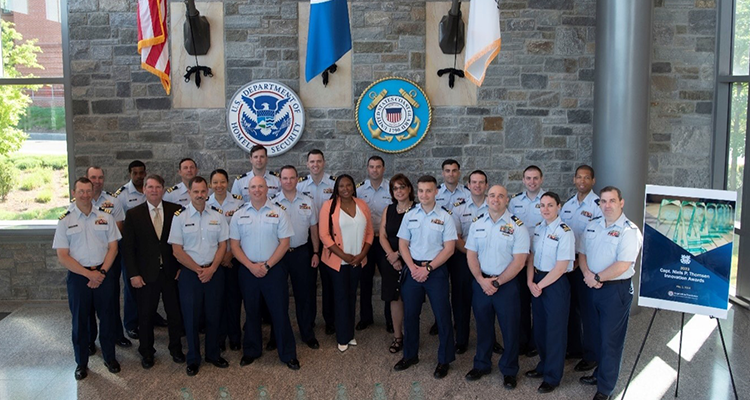
Seven teams were honored with 2023 Capt. Niels P. Thomsen Innovation Awards in a ceremony on May 2, 2024, at Coast Guard Headquarters. Representing the teams are, from left: back row – Lt. Cmdr. Nathaniel Dufresne, Lt. Asa Jawahir, Lt. Cmdr. Thomas Garcia, Lt. j.g. Alex Tschida, Lt. Cmdr. Ryan Taylor, Cmdr. Lukas Spurrier, Lt. Drew Cheneler; middle row – Cmdr. Matthew Smith, Brian Ellis, Lt. Cmdr. Nikea Natteal, Jesse Scott, Jessika Hunt, Celestina Budovec, Lt. Cmdr. Shawn Antonelli, Lt. John Roddy, Lt. Kailee Evereteze; front row – Lt. Kevin Deininger, Lt. Cmdr. Sammy Hill, Lt. j.g. Alaric Stone, Lt. Cmdr. Nick Phillips, Lt. Victoria Martucci and Lt. Garen Anderson. U.S. Coast Guard photo by Petty Officer 2nd Class Ronald Hodges Jr.
“Tomorrow looks different, and so will we.” James Knight, deputy assistant commandant for acquisition and director of acquisition services, used the commandant’s oft-repeated message to the workforce to open the Capt. Niels P. Thomsen Innovation Awards Ceremony that took place during the Coast Guard Senior Leadership Conference on May 2.
The annual awards recognize innovative efforts by the Coast Guard workforce to increase efficiency or productivity or provide other process improvements. Their namesake is considered a legendary Coast Guard innovator; the chain stopper Thomsen developed in 2008 was credited with dramatically improving the safety of buoy tending operations for the Coast Guard.
Knight thanked the winning teams that have “pioneered solutions that enhance and improve Coast Guard operations and service readiness.” Looking toward the future, he said, “We hope they will also serve to inspire everyone to adapt the mindset of relentless innovation.”
While innovation has always been key, it is especially important in these rapidly changing times, stressed Adm. Linda Fagan, Coast Guard commandant.
“The world continues to change at an accelerating pace,” Fagan said. “Technology continues to advance at an ever-quickening pace. We need to challenge our assumptions around how we’re operating, challenge assumptions around risk, think creatively, try new ideas, and when they don’t work, try another new idea. These are all things that are in the wheelhouse now.”
Fifty-nine projects were considered for recognition in 2023.
This year’s winners:
Science or Technology
Dark Vessel Detection at Scale by Commercial Analytics Assessment Team
Lt. Cmdr. Ryan Taylor, Lt. Cmdr. Nikea Natteal, Patrick Richmond, Lt. John Pope, Chief Warrant Officer 2 Patrick Jackson, Chief Petty Officer Samuel Hammond, Petty Officer 1st Class Drew Logan, Petty Officer 2nd Class Jocelyn Miller, Petty Officer 2nd Class Joel Gadd, Petty Officer 2nd Class Clifford McRorie II, Lt. j.g. Alaric Stone, Lt. j.g. Bonni Hartman, Mathew Frank, David Newberry and Mark Winding
The Commercial Analytics Assessment Team assessed and identified satellite imagery solutions that automatically detected dark vessels – seagoing craft that do not publicly share their location – in vast ocean areas, enhancing maritime security and situational awareness. This technology played a key role in detecting narcotics smuggling, resulting in the largest cocaine seizure in a partner country’s history.
Operations or Readiness
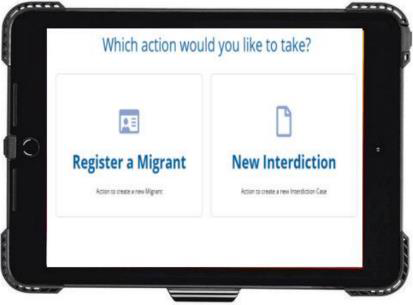
A tablet displays an initial menu option on the Migrant Interdiction Operations (MIO) application. The MIO application allows operators to register a migrant or create a new interdiction case. As a device agnostic application, units will be able to complete a variety of MIO functions from their Coast Guard mobile devices. Once the data is inputted and pending connectivity, the device will sync on the Coast Guard network to allow for near-real-time updates of MIO activities. This automatic sharing of information will make MIO operators more efficient and productive with their time.
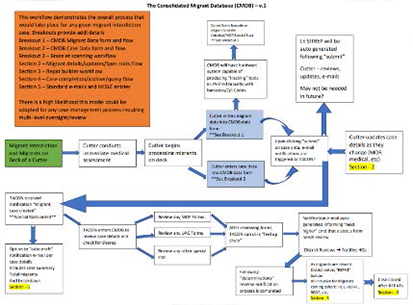
This image shows the MIO application wireframe from its initial conception and explains the process of how migrant data flows throughout the system. While the process has been slightly improved from this image, the idea of how a consolidated migrant database (the initial name for the MIO app) could automate multiple steps for the MIO mission and provide the Coast Guard with real-time data drove the development of this system.
Innovation in Migrant Interdiction Operations by Migrant Interdiction Operations Application Team
Lt. Cmdr. Shawn Antonelli, Lt. Kailee Evereteze, Lt. Garen Anderson, Lt. j.g. Jarett Woodbury, Lt. Victoria Martucci, Lt. Cmdr. Nick Phillips, Lt. John Roddy, Lt. Benjamin Arocho, Lt. Ryan Major and Lt. j.g. Casey Whitehead.
The ENFORCE Migrant Interdiction Operations application is a tool that was brainstormed during Operation Vigilant Sentry – a Department of Homeland Security (DHS) operation to deter and dissuade mass migration in the Caribbean – and presented as a technological solution to speed up the manual process of managing migrants from embarkation to repatriation. It is a system that utilizes a web application and cameras to capture migrant identification information and transfer it into a consolidated migrant database that is shared with key stakeholders to support a wide array of government activities. The stakeholders include Coast Guard command centers, enforcement staff and international liaisons, the DHS Headquarters Office of Law Enforcement Policy, Coast Guard international liaisons and partner agencies. The system is capable of storing and sharing data, including migrant personal identifiable information, migrant repatriation progress, family separation, medical issues, asylum requests, cutter transfers, statistical data and more. Prior to the migrant interdiction operations system’s development, these steps were completed through slow, non-standardized practices such as Excel spreadsheets, emails and notebooks. This archaic way of doing business cost the Coast Guard millions of dollars in additional manpower needs and required the temporary deployment of more than 100 Coast Guard personnel per month to support surge operations in District 7. Reassignment of Coast Guard personnel pulled resources from other units and reduced productivity across the service as a whole.
“We used pen and paper to track down information in logbooks and when they would transfer from cutter to cutter, that information would be transferred by pen and paper,” Antonelli said. “We had to come up with a system in which it could be entirely encapsulated and seen by all levels of the chain of command to ensure the information is free flowing.”
In the future, the tool will be fully integrated into all Coast Guard operational mission sets, Antonelli continued. He hopes that leads to other innovations for processing large scales of information.
Operations or Readiness
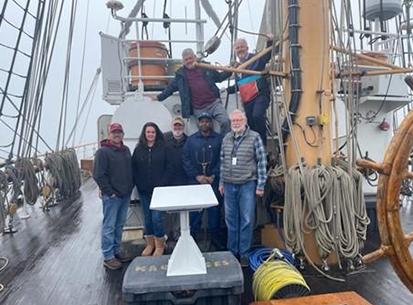
Starshield installation crew onboard Coast Guard Cutter Eagle in New London, Connecticut, where the first Starshield prototype was installed. It was a challenge finding a location to install the antenna amid Eagle’s many sails and moving beams so it has a clear view of the sky. From left: Brian Fachko (Chugach), Noelle Rhoades (Naval Information Warfare Center), Jamin Ward (Chugach), Lt. Asa Jawahir (C5I Service Center-Deployed Connectivity Section (C5ISC-DCS), William Vanden-Houten (C5ISC-DCS), Keith Whelpley (C5ISC-DCS) and Ressel Watkins (C5ISC-DCS).
Coast Guard Network Modernization: Starshield and 5G Cellular Technology by Starshield and Cellular Comms Network Team
Lt. Asa Jawahir, Lt. j.g. Alex Tschida, Lt. Cmdr. Thomas Garcia, Lt. j.g. Mark Wood, Lt. j.g. Thomas Espinal, Lt. j.g. Lee Francis, Chief Warrant Officer Robert Allen, Senior Chief Petty Officer James Stewart, Eric Woynaroski, Jeff Tschiggfrie, Russ Watkins, Ed Soliven, William Vanden Houten, Allison Britton, Nak Chong, Keith Whelpley, Gary Kloss, Darryl Lewis, Kalvin Baker, Ken Schiro, Dennis Hyde, Andy Weber, Eric Rozon, Michael Locke, Lt. Michael Kenyon, Ensign Leland Wilson, Chief Petty Officer Abidenas Neves, Isaac Baiden, Juan Colon and Josh Hockenberry.
The Command, Control, Communications, Computers, Cyber and Intelligence (C5I) Service Center Networking Team revolutionized the capability and resiliency of the Coast Guard network by deploying Starlink, a commercial proliferated low earth orbit satellite service that boosted underway cutter network speeds from six megabits per second to 135 megabits per second, matching home internet speeds. This technology has transformed underway operations by making critical Coast Guard applications easily accessible and usable around the world. The team completed 60 cutter installations in fiscal year 2023 and plans to complete another 80 installations in fiscal year 2024. Shoreside, the team proactively deployed cellular connections through AT&T’s FirstNet, providing an alternate high-speed network to command centers to support critical networked voice systems like Voice-Over-IP and Dial-In-Phone-System during terrestrial network outages.
A faster and more reliable network both afloat and ashore not only ensures continuity of mission operations but also unmeasurably boosts morale and quality of life for the crew and their families, making sea duty and Coast Guard service more attractive. These innovations have consequentially opened doors for increased recruitment and retention in the Coast Guard.
The team created a cellular backup network connection for command centers, Tschida said. “Essentially, the idea and purpose of it is, in the event that any kind of network connection loss happens to any of the consumer demand centers, there’s a separate cellular connection that will jump online and maintain network connectivity.”
Administration, Training or Support
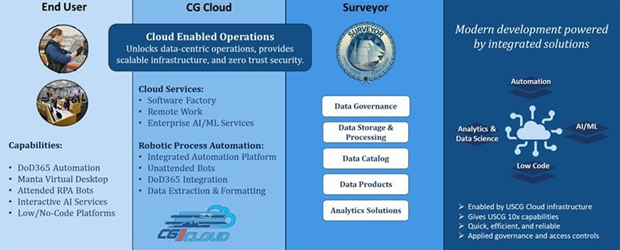
C5ISC is implementing dynamic solutions to streamline operations and improve user experience.
Robotic Process Automation in the Coast Guard by Team Talos
Capt. Shannon Smith, Cmdr. Jonathan White, Cmdr. Lukas Spurrier, Lt. Drew Cheneler, Lt. Hessamoddin Shafeian, Lt. j.g. Alaric Stone, Petty Officer 3rd Class Theodore Sherrill, Petty Officer 3rd Class Evan de la Pena, Shamara Wilkins, Jessika Hunt, Celestina Budovec and Devon Gunter.
Robotic process automation (RPA) is a transformative technology that allows the Coast Guard workforce to automate repetitive and manual tasks. RPA is authorized software that emulates human actions on a standard workstation to move data between systems, organize Excel spreadsheets or even populate Coast Guard memos and emails. RPA has delivered a substantial return on investment by reducing man-hours, increasing accuracy and increasing throughput across multiple mission areas. RPA is a key component to the ongoing Coast Guard technology revolution. Even in its initial stages and deployment by the team, RPA solutions are in strong demand across the Coast Guard. The Human Resources; Intelligence; Finance; and Command, Control, Communications, Computers and Information Technology Directorates are rapidly pursuing RPA solutions to streamline processes and liberate personnel from time-exhaustive, repetitive tasks. To date, the Coast Guard has deployed over 62 tailor-made automation bots that are saving the organization around 85,000 man-hours per year, helping transact more than $2 billion worth of Coast Guard funds and are being used in every district.
Ultimately the team hopes to deploy this technology across the Coast Guard, freeing people from repetitive tasks and allowing them to focus more on the mission, Cheneler said.
Culture Change
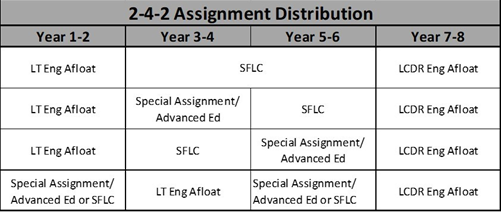
2-4-2 Graphic
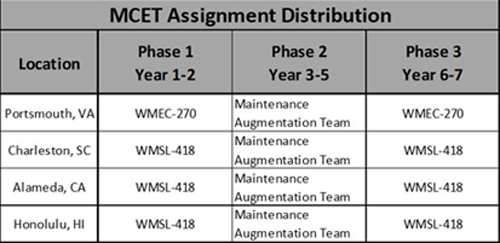
MCET 2-3-2 Graphic
Naval Engineering Structured Assignment Programs by the Office of Naval Engineering
Brian Ellis, Capt. Thomas Lowry, Cmdr. Matthew Smith and Lt. Cmdr. Nathaniel Dufresne.
The Office of Naval Engineering team has implemented two talent management programs to support modernized cutter readiness: for officers, the afloat engineer officer “2-4-2” program; and for enlisted personnel, the major cutter engineering technician (MCET) “2-3-2” program. These structured assignment programs are focused on major cutter operations with substantial incentives provided in exchange for obligated service to qualified applicants. The “2-4-2” program was implemented to establish an assignment pipeline filling critical billets and develop skills needed to excel in the O-4 engineer officer afloat position. This program includes engineer officer tours at both the O-3 and O-4 ranks that bookend an engineering staff tour in a key support role. In the program’s first two years, 20 members were selected, providing 160 years of obligated service, including 80 years afloat. The MCET program was rolled out, targeting E-4 and E-5 ranks for damage controlmen, electrician’s mates and machinery technicians and providing cutter and geographic stability for two afloat tours and one shoreside support tour. The highly desired incentives and targeted return on investment strategy in these programs signifies the service’s commitment to investing in its technical workforce and improves readiness.
“The Coast Guard is having trouble keeping naval engineers, especially those specializing within major cutter engineering systems,” Dufresne said. This program helps attract the workforce by laying out multiple tours in advance, establishing predictable assignments, and at times, even offering geographic stability across assignments, according to Dufresne.
Auxiliary Achievement
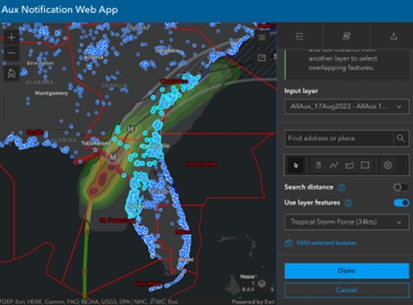
The team uses Geographic Information Systems (GIS) to overlay and display real-time data during critical events.
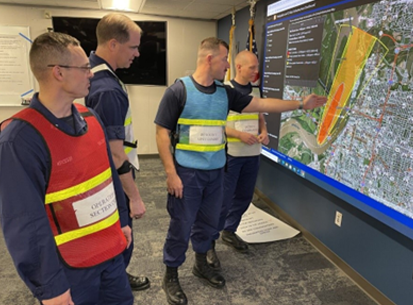
Emergency Management Team members use GIS to guide vessels to safely navigate to critical locations.
Emergency Management Transformation in District 8 by 8th Western Rivers Region Emergency Management Team
Commodore Richard Lawrence, Shawn Steadman, Bernard Weston Morosco, Jesse Scott, Commodore Robert Tippet, Dennis Pearson, Frank Harrison Merrill, Harvey Siegal, Commodore Jackson Gumb and Barclay Stebbins
In an era of growing challenges on waterways and in communities, the 8th Western Rivers Region (8th WRR) Emergency Management Team – led by Commodore Richard L. Lawrence – has implemented groundbreaking initiatives that have enhanced operational capabilities, redefining emergency management practices.
Their notable achievements include developing a unique organizational structure to support incident missions, which has improved agility and responsiveness, particularly evident during hurricanes and the COVID-19 pandemic. The Integration of Geographic Information Systems (GIS) project headed by Jesse A. Scott has provided real-time spatial data during critical events, enhancing situational awareness and decision-making. Through leadership and management of emergency response efforts, particularly in training and preparedness under Wes Morosco, Dennis Pearson and Frank Merril, the team has elevated response efforts, advancing the qualifications and readiness of over 70 participants.
Cmdr. Joel Magnussen Innovation Award for Management
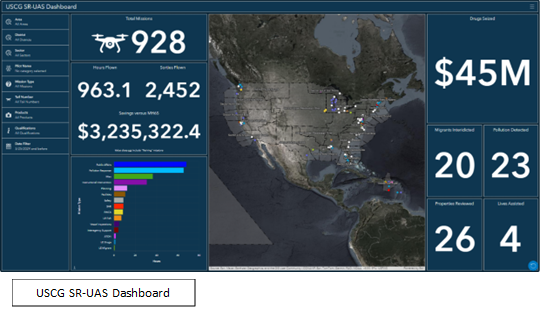
The ArcGIS Short-Range Unmanned Aircraft System (SR-UAS) Dashboard is part of a multi-functional fleet management database. The SR-UAS missions are entered by operators and displayed geographically. Mission data can be filtered a myriad of ways, providing detailed program oversight from total fleet wide data down to the individual operator and system level.
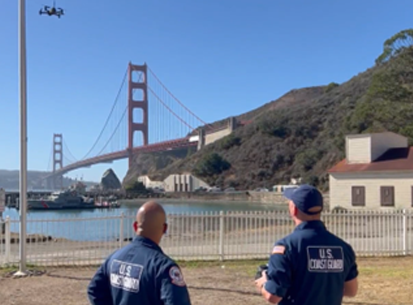
Coast Guard SR-UAS pilots from Pacific Strike Team conduct a mapping mission in San Francisco Bay, California. Using this information, the SR-UAS program developed protocols to integrate aerial operations with remote underwater vehicle system technology to help develop cutting-edge techniques in waterway mapping. From left: Petty Officer 1st Class Zachary Strack and Petty Officer 1st Class Jesus Velarde.
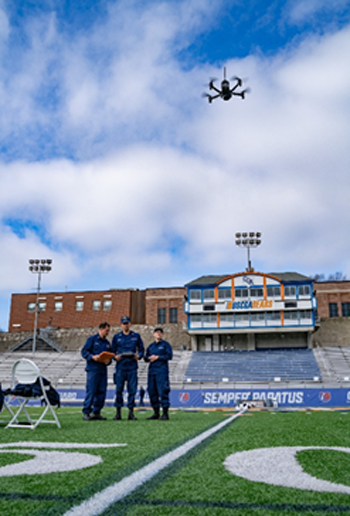
Coast Guard Academy students and SR-UAS instructor perform a test flight during a training course on Feb 21, 2024. The SR-UAS team partnered with Coast Guard Academy leadership in developing a UAS college curriculum that will allow cadets to leave the academy with the SR-UAS competency. From left: Lt. Kevin Deininger, Cadet Mattia Seazzu and Lt. Angel Fay.
Short-Range Unmanned Aircraft Systems (SR-UAS) by U.S. Coast Guard SR-UAS Program
Lt. Cmdr. Sammy Hill, Lt. Cmdr. Matthew Hardgrove, Lt. Zachary Speck, Lt. Kevin Deininger, Lt. j.g. Jacob Cheeseman and Petty Officer 1st Class Matthew Riemer.
The U.S. Coast Guard started the SR-UAS program in January 2023. In just one calendar year, the team created the first-ever SR-UAS Training and Standardization Division at Aviation Training Center Mobile. The team fielded 212 aircraft, qualified over 400 SR-UAS pilots and participated in multiple industry-leading innovative endeavors. During this short time, the program’s impacts have been felt across all 11 Coast Guard statutory missions. The program instituted the first enterprise-wide ArcGIS application within the Coast Guard’s Geospatial Information System Portal, Sextant; partnered with the Great Lakes Center of Expertise and Marine Environmental Protection for cutting-edge initiatives in water mapping; and developed protocol for SR-UAS to be used in conjunction with the Coast Guard’s subsurface remotely operated vehicles to blend aerial and underwater mapping to quickly reopen ports. The team partnered with U.S. Coast Guard Academy leadership in developing a UAS college curriculum that will allow cadets to leave the academy with the SR-UAS competency. Pilots from the short-range program have assisted in saving lives, interdicted drugs and migrants and provided critical responses to both environmental and natural disasters. The SR-UAS Program embodies a culture of innovation, empowering members from across the service to find new and creative ways to utilize this exciting new technology.
“It’s a force multiplier across all levels of satellite missions without hyper-dimensions,” Hill said. “It’s basically a flying camera or video camera that can push data in near real time or in a lot faster terms than we’ve done with aircraft or surface vessels up to this point.”
For information on Coast Guard R&D: Research, Development, Test and Evaluation Program page and Innovation Program page